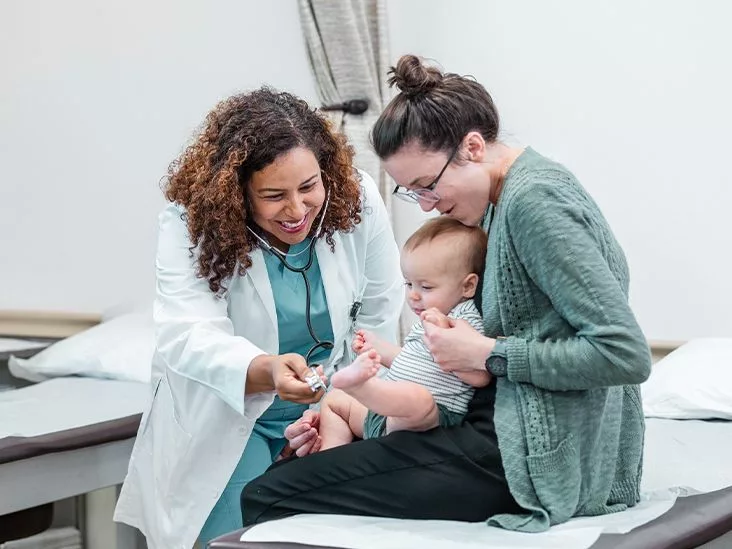Let’s cut to the chase: a pediatrician — sometimes called a child doctor — is a medical professional whose whole job is making sure kids stay healthy, grow properly, and feel safe when they’re under the needle (or the stethoscope). From newborn check‑ups to navigating a teen’s first break‑up‑induced anxiety, they’re the go‑to experts for everything that happens between birth and early adulthood.
Knowing exactly what a pediatrician does helps you feel confident when you book that next appointment, decide whether you need a specialist, or simply wonder why your child’s doctor keeps talking about “anticipatory guidance.” So, grab a coffee, settle in, and let’s walk through the day‑to‑day world of pediatric care together.
Core Responsibilities
Monitoring Growth & Development
One of the first things a pediatrician does at every visit is check the growth chart. That colorful graph isn’t just for decoration; it shows weight, height, and head circumference compared to age‑specific percentiles. By spotting a dip or a sudden jump, the doctor can catch nutrition issues, hormonal imbalances, or developmental delays early—often before you even notice them at home.
Preventive Care & Vaccinations
Vaccines are the unsung heroes of pediatric health. A pediatrician follows the CDC immunization schedule to make sure your child gets the right shots at the right time. Alongside shots, they offer guidance on safe sleep, car seat safety, and diet—what we call “anticipatory guidance,” because it’s all about preparing you for the next stage of your child’s life.
Diagnosing & Treating Common Ailments
From ear infections and colds to minor cuts and rashes, most kids’ everyday health hiccups land on a pediatrician’s desk. They’ll listen, examine, maybe swab a throat, and then prescribe antibiotics, pain relievers, or simply reassurance. The key difference? They know how to talk to kids—often using crayons or simple analogies—to get the most accurate symptoms.
Managing Chronic & Complex Conditions
Some children need more than routine check‑ups. Asthma, type 1 diabetes, ADHD, and developmental disorders require ongoing monitoring, medication adjustments, and coordination with specialists. A pediatrician acts as the central hub, ensuring all pieces of care—school nurses, therapists, and subspecialists—fit together smoothly.
Example: Asthma Care Plan
Imagine a 7‑year‑old named Maya who wheezes during soccer. Her pediatrician writes an asthma action plan: a daily inhaled steroid, a rescue inhaler for flare‑ups, and a trigger‑avoidance checklist (dust mites, pollen). The doctor also sets up a follow‑up every three months to adjust medication and teach Maya’s parents how to use a peak‑flow meter. That plan keeps Maya playing without panic.
Pediatric Services
Well‑Child Visits
These are the backbone of pediatric appointments. The schedule is pretty predictable:
- Newborn: within 1 week, 1 month, 2 months
- Infancy: 4, 6, 9, 12, 15, 18 months
- Early childhood: 2, 4, 6 years
- Pre‑teen & teen: annually from 7 years onward
During each visit, the doctor checks vitals, measures growth, reviews milestones, updates vaccines, and answers your endless “Is this normal?” questions.
Urgent Care vs. Routine Care
Not every cough needs a same‑day appointment, but you don’t want to wait too long either. Most pediatric offices have an after‑hours line: call, describe symptoms, and they’ll tell you whether to come in, schedule a next‑day slot, or head to urgent‑care. It’s a lifesaver when a fever spikes at 2 a.m.
Telehealth & Virtual Check‑Ups
Virtual visits exploded after 2020, and they’re here to stay. Telehealth works great for:
- Follow‑up medication checks
- Rash assessments (clear photos help)
- Behavioral health counseling
It’s not a substitute for a physical exam with a stethoscope, but it adds convenience for busy families.
In‑Person vs. Telehealth Comparison
| Aspect | In‑Person | Telehealth |
|---|---|---|
| Physical Exam | Full assessment, auscultation, reflex testing | Limited; relies on visual cues and parental description |
| Convenience | Travel time, waiting room | From home, no commute |
| Urgent Issues | Immediate hands‑on care | Best for advice; may need in‑person follow‑up |
| Cost | Often covered by insurance | Usually covered, but check your plan |
Pediatrician vs Child Doctor
Training & Scope
A pediatrician completes a three‑year residency focused exclusively on infants, children, and adolescents. A family physician (sometimes called a “child doctor”) trains across all ages, so while they can treat kids, they haven’t spent as many hours mastering the nuances of, say, newborn reflexes or adolescent mental health.
When to Choose One Over the Other
If you want a doctor who lives and breathes child health—especially for newborns or complex pediatric conditions—a pediatrician is ideal. If you prefer a single provider for the whole family, a family physician might be a better fit. Both can provide excellent care; the decision often boils down to personal comfort and the specific needs of your child.
Choosing a Pediatrician
Credentials & Board Certification
Look for “board‑certified pediatrician” on the office website. According to the American Board of Pediatrics, board certification means the doctor has passed rigorous exams and commits to ongoing education.
Practical Considerations
- Location: Is the office near work or school?
- Hours: Do they offer early mornings, evenings, or weekend slots?
- Insurance: Does your plan list them as in‑network?
- Language: Is there a staff member who speaks your primary language?
Personal Fit & Communication
Schedule a quick “meet‑and‑greet” before committing. Ask about their approach to nutrition, discipline, and mental health. Notice whether they listen patiently, use layperson’s language, and make eye contact with your child—not just you.
Vet‑ting Checklist (Downloadable)
We’ve put together a printable PDF you can take to your first consultation. It covers everything from credentials to bedside manner. (Insert link to PDF if you have one.)
Appointment Expectations
First Visit (Newborn to 2 Months)
Expect a lot of paperwork: a detailed family medical history, consent forms, and a discussion about feeding (breast vs. bottle), sleep safety, and newborn screening tests. The doctor will perform a “well‑baby exam” that includes checking the heart, lungs, hips, and reflexes.
Follow‑Up Visits
Later appointments become more routine: growth measurement, vaccine administration, and a conversation about milestones (walking, talking, school readiness). If anything feels off—like a lag in speech—the pediatrician may order a hearing test or refer to a speech therapist.
Handling Sensitive Topics
Things like anxiety, bullying, or early puberty can feel uncomfortable. Pediatricians are trained to create a safe space. They’ll ask open‑ended questions (“How have you been feeling at school?”) and often involve the parent only if necessary, preserving the child’s privacy.
Expert Insight
Dr. Elena Martinez, a board‑certified pediatrician with 15 years of practice, says, “Our role is part‑doctor, part‑coach. We guide families through the messy, beautiful journey of growing up, and that means sometimes talking about topics that feel taboo.”
Salary and Outlook
Median Salary & Range
According to the U.S. Bureau of Labor Statistics, the median annual wage for pediatricians in 2025 hovers around $185,000, with a range from $130,000 for those in rural clinics to over $250,000 for subspecialists in major metropolitan hospitals.
Factors Influencing Earnings
- Geographic location: coastal cities tend to pay more.
- Practice setting: private practice often yields higher income than salaried hospital positions.
- Subspecialty: pediatric cardiology or oncology can command a premium.
Job Growth & Demand
The field is projected to grow modestly (about 2 % from 2020‑2030), but the demand for child doctors remains strong because families always need primary care for kids. As more children receive early‑intervention services, pediatricians who specialize in developmental pediatrics are seeing a surge in referrals.
Infographic Idea (Not displayed here)
Imagine a map of the U.S. with salary bands shaded by state—great for visual learners who want to see where their future practice might be most lucrative.
Real Stories
Story 1: From Newborn Checks to Asthma Management
Emily brought her son, Luca, to the office for his 2‑month check‑up. A routine lung exam revealed slightly wheezy breaths. The pediatrician ordered a simple peak‑flow test and diagnosed mild asthma. Together they crafted an action plan—quick inhaler, regular check‑ups, and environmental tweaks (air purifier, no smoking). Today, Luca runs the local soccer field without a cough, and Emily swears by the early detection that saved them countless ER trips.
Story 2: Spotting Developmental Delays Early
When 18‑month‑old Maya wasn’t babbling as much as other kids, her pediatrician noticed the lag during a well‑child visit. He referred her to a speech‑language pathologist and began weekly “talk‑time” sessions. By age three, Maya was speaking in full sentences and thriving socially. The pediatrician’s keen eye turned a potential lifelong challenge into a success story.
Parent Quote
“I always feel heard—my pediatrician explains everything in plain language and never makes me feel rushed,” says Carlos, a dad of two. Empathy and clear communication are the invisible ingredients that turn a routine check‑up into a trusting partnership.
Wrapping It Up
So, what does a pediatrician do? In a nutshell, they safeguard your child’s physical, emotional, and social health—from the first newborn exam to navigating teenage anxiety. They vaccinate, diagnose, treat, and educate, all while building a relationship with you and your family that can last decades.
Now that you’ve got the inside scoop, you’re better equipped to choose the right pediatrician, schedule appointments confidently, and understand the value of each well‑child visit. Got questions or personal experiences to share? Drop a comment below, or reach out to a local child doctor—you’ll be surprised how welcoming the pediatric community can be.


















Leave a Reply
You must be logged in to post a comment.